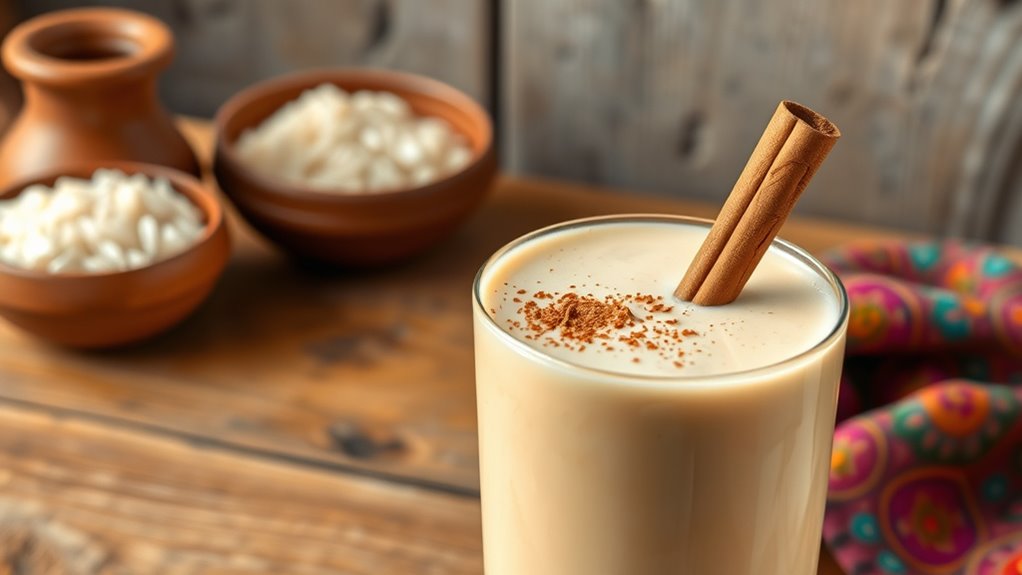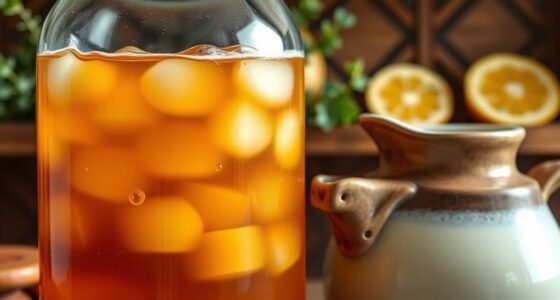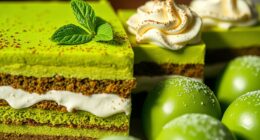Mexican horchata is a traditional, rice-based drink with a rich history blending indigenous and Spanish influences. It’s often made from soaked rice, cinnamon, sugar, and water, creating a sweet, creamy refreshment enjoyed during celebrations and family gatherings. Modern twists include vanilla, coconut milk, or vegan options. This versatile beverage symbolizes cultural resilience and community bonds. If you want to discover authentic recipes and more about its fascinating journey, keep exploring.
Key Takeaways
- Mexican horchata is a traditional rice-based beverage with roots blending indigenous and Spanish cultures.
- It typically includes rice, cinnamon, sugar, and water, resulting in a sweet, creamy drink.
- Modern recipes often incorporate vanilla, almond, or coconut milk, and can be adapted for vegan and gluten-free diets.
- Horchata plays a key role in festivals and community gatherings, symbolizing cultural identity and heritage.
- It is enjoyed as a refreshing drink, dessert, or ingredient in modern culinary creations, reflecting ongoing tradition and innovation.

Have you ever wondered about the origins of horchata, a sweet and invigorating beverage enjoyed across many cultures? This drink’s roots stretch back centuries, blending indigenous traditions with Spanish influences. Originally, horchata was crafted from a variety of grains and seeds, depending on the region. In Mexico, rice became the primary ingredient, transforming into the beloved rice milk known as Mexican horchata. Its cultural significance runs deep, often associated with festive occasions, family gatherings, and local traditions. Over time, horchata became more than just a drink; it evolved into a symbol of cultural identity, representing a blend of history and community. Today, it’s a staple in Mexican cuisine and enjoyed worldwide, with each region adding its unique twist.
Modern variations of horchata reflect both ongoing tradition and contemporary tastes. While the classic recipe combines rice, cinnamon, sugar, and water, many modern versions incorporate innovative ingredients. Some add vanilla or almond extract to enhance flavor, while others experiment with coconut milk or even oat milk to cater to dietary preferences. These adaptations make horchata accessible to a broader audience and allow for creative expression. You might find vegan or gluten-free options, emphasizing inclusivity and health-conscious choices. Additionally, some chefs elevate horchata by turning it into ice cream, smoothies, or cocktails, showcasing its versatility. Interestingly, the preparation and consumption of horchata also serve as a cultural tradition, strengthening community bonds and preserving heritage.
You can enjoy horchata as a revitalizing beverage on a hot day, a comforting treat during festivals, or as a dessert accompaniment. Its smooth, creamy texture and aromatic cinnamon make it instantly recognizable. When you make it at home, you participate in a centuries-old tradition, connecting with a rich cultural history. Whether you stick to the classic recipe or experiment with modern variations, you’re keeping alive a tradition that has traveled through time and across continents. Each sip not only refreshes but also tells a story of cultural resilience and adaptation. So, next time you enjoy a glass of horchata, remember its deep roots and the many ways it continues to evolve, serving as a delicious reminder of cultural significance and innovation.
Frequently Asked Questions
Can Horchata Be Made With Alternative Grains or Nuts?
Yes, you can definitely make horchata with alternative grains or nuts. Nut-based horchata, like almond or cashew, offers a creamy, rich flavor, while alternative grains like millet or quinoa add unique textures and tastes. Simply soak your chosen ingredients, blend them with water, strain, and sweeten to taste. Experimenting with these options allows you to create delicious, customized horchata variations that suit your preferences and dietary needs.
How Long Does Homemade Horchata Stay Fresh in the Refrigerator?
Your homemade horchata stays fresh in the fridge for about 2 to 3 days, like a delicate flower in bloom. Keep an eye out for spoilage indicators—sour smell, off taste, or a slimy texture—and enjoy it before these signals appear. To preserve its sweetness and flavor, store it in an airtight container and give it a good shake before pouring, ensuring every sip is as invigorating as the first.
Are There Variations of Horchata in Different Mexican Regions?
Yes, you’ll find variations of horchata across Mexican regions, each showcasing unique regional flavor profiles and cultural significance. For example, in the north, you might taste horchata with added cinnamon and vanilla, while in the Yucatán, it often includes almonds or coconut. These regional differences reflect local ingredients and traditions, making horchata a diverse and culturally rich beverage enjoyed throughout Mexico.
What Are Some Popular Traditional Mexican Horchata Toppings?
You’ll love adding traditional garnishes like cinnamon sticks, crushed almonds, or a sprinkle of ground cinnamon to your horchata for a festive presentation. Fresh fruit slices, such as strawberries or oranges, also make eye-catching toppings that enhance the flavor. These traditional garnishes not only elevate the drink’s appearance but also add delightful textures and aromas, making your horchata experience more authentic and celebratory.
Is Horchata Suitable for People With Lactose Intolerance?
Yes, horchata is suitable for people with lactose intolerance because it’s naturally lactose free and serves as a dairy alternative. You can enjoy its creamy texture without worrying about lactose. Just guarantee you select or prepare a traditional rice-based horchata, which doesn’t contain dairy. It’s a delicious, invigorating beverage that fits well into a lactose-free or dairy-free diet, making it a great choice for those avoiding lactose.
Conclusion
Now that you know the rich history of Mexican horchata, you’ll appreciate its cultural significance and invigorating taste even more. Did you know that horchata’s popularity has surged worldwide, with the global rice milk market expected to reach $2.8 billion by 2025? Next time you sip this creamy beverage, remember you’re enjoying a centuries-old tradition that continues to delight people everywhere. So, why not try making your own and experience its sweet, nutty flavor firsthand?









